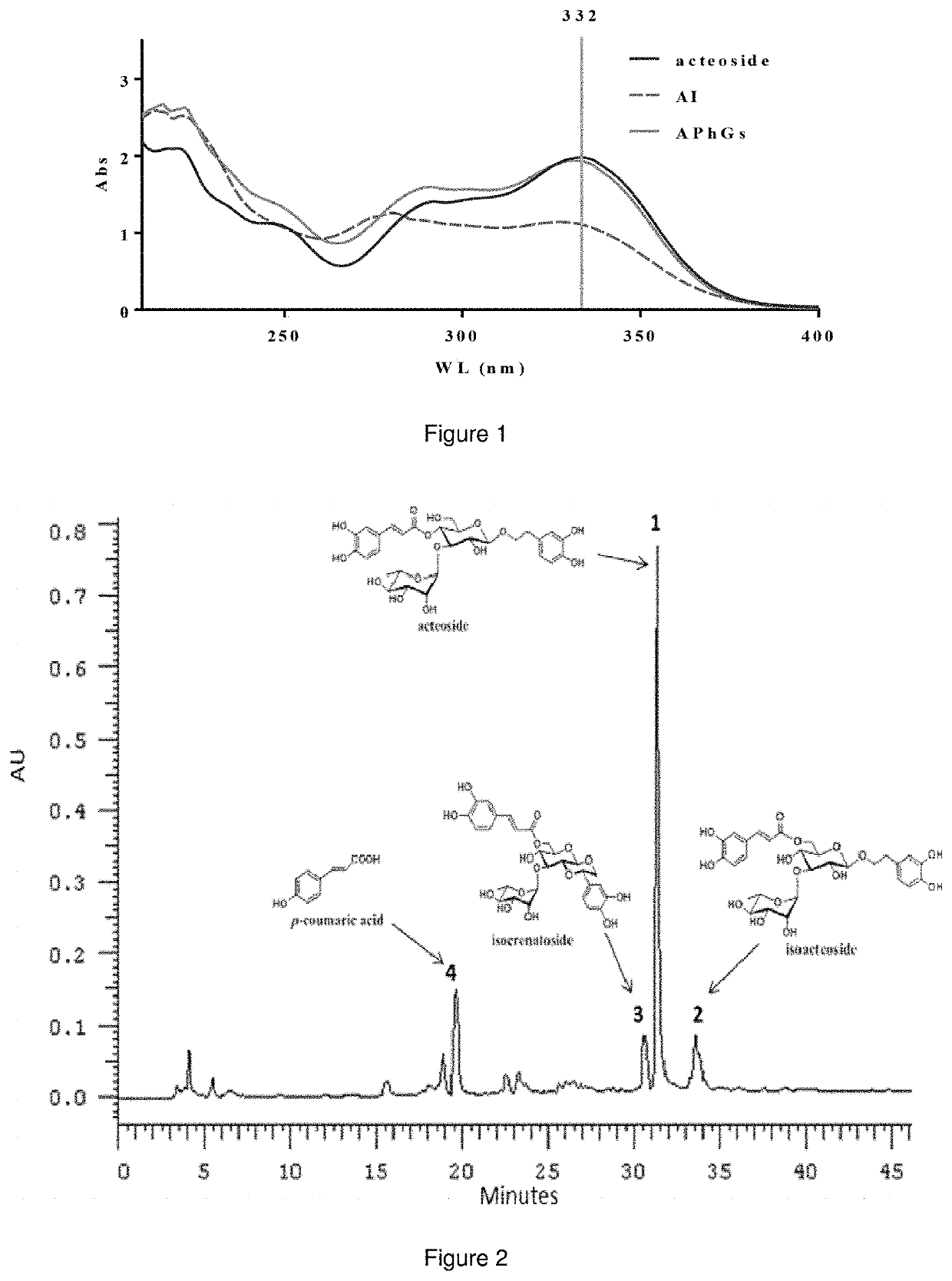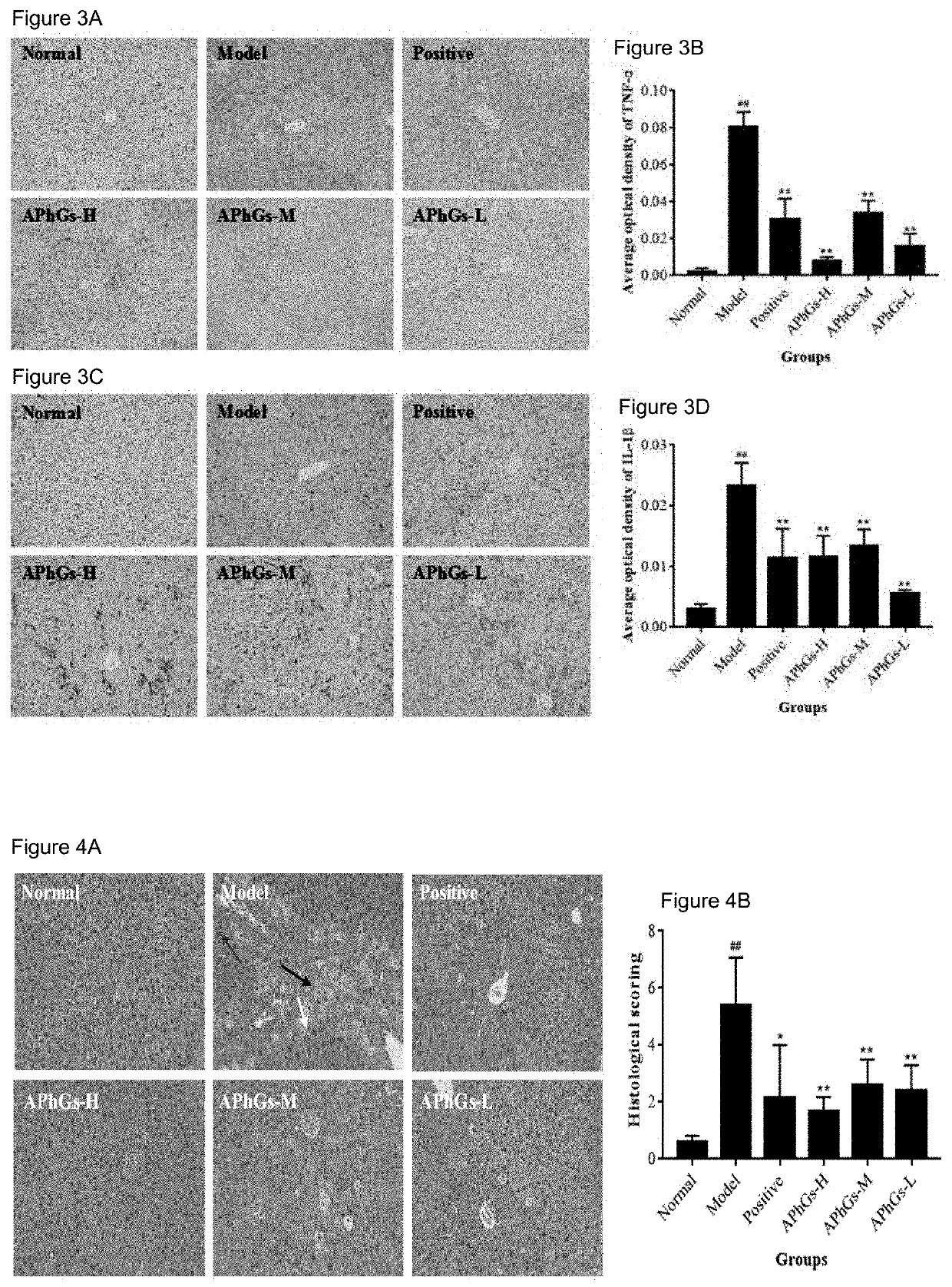Phenylethanoid Glycoside Extract from Acanthus Ilicifolius L., Preparation Method thereof and Use as Anti-liver Injury Medicament
- Summary
- Abstract
- Description
- Claims
- Application Information
AI Technical Summary
Benefits of technology
Problems solved by technology
Method used
Image
Examples
example 1
[0029]Preparation and identification of phenylethanoid glycoside extract.
[0030]1. Preparation of Phenylethanoid Glycoside Extract
[0031]The crude powder of the plant was obtained after the dried whole plant of A. ilicifolius L. was smashed and passed through a 20-30 mesh sieve. The 95% ethanol solution (10 L) was added to the powder of 1 kg. After being soaked for 2 h and refluxed for 3 h, the extract of the powder was collected. Then the filter residue was refluxed and extracted for another 1.5 h with 95% ethanol solution (8 L). The two extracts were combined, concentrated and subjected to D101 macroporous resin column chromatography, eluted successively by 10%, 30% and 50% ethanol solutions for 4 column volumes, respectively. The fraction eluted with 50% ethanol solution was collected and dried to obtain the phenylethanoid glycoside extract.
[0032]2. Identification of Phenylethanoid Glycosides in the Extract
[0033]The characteristic of the ultraviolet spectrum of phenylethanoid glyco...
example 2
[0035]Pharmacodynamics of phenylethanoid glycoside extract from A. ilicifolius L. on CCl4-induced mouse liver injury model in vivo.
[0036]1. Experimental Methods
[0037]Forty eight C57 mice (20-22 g) of both genders were supplied by the Experimental Animal Center of Hubei Province, China (NO.42000600033017). The above 48 mice were randomly divided into 6 groups (8 mice each group), and the phenylethanoid glycoside extract of the present disclosure (the phenylethanoid glycoside group, APhGs) were intraperitoneally injected with the doses of 300 mg / kg (high dose group), 150 mg / kg (medium dose group), and 75 mg / kg (low dose group). The positive group was given silybin (150 mg / kg), and the normal group, as well as model group was given normal saline. All groups were treated as above once / d for 3 consecutive days. Two hours after the last administration, the normal group was intraperitoneally injected with 15 μL of olive oil / mouse, and the other groups were intraperitoneally injected with 1...
example 3
[0061]Study on the pharmacodynamics of APhGs on CCl4-induced L-02 hepatocyte damage in vitro.
[0062]1 Experimental Methods
[0063]L-02 hepatocytes were provided by the China Center for Type Culture Collection (CCTCC). The L-02 hepatocytes were cultured in a medium containing 1640 complete culture medium and DMEM complete medium with 5% CO2 at a constant temperature (37° C.). The cells were harvested in the exponential growth phase. A suspension of 1×106 cells / mL was prepared, and then 100 μL of this suspension was added to each well of a 96-well plate with tested medium. The groups were divided into: normal group, negative control group, CCl4 model group, positive group (silybin), and high-, medium-, and low-dosage APhGs groups. After incubation for 24 h, the cells in the experimental group and the positive group were treated with different concentrations of APhGs and silybin. Both the CCl4 model group and the negative control group were added with the same amount of DMSO. Each treatme...
PUM
| Property | Measurement | Unit |
|---|---|---|
| Fraction | aaaaa | aaaaa |
| Fraction | aaaaa | aaaaa |
| Fraction | aaaaa | aaaaa |
Abstract
Description
Claims
Application Information
 Login to View More
Login to View More - R&D
- Intellectual Property
- Life Sciences
- Materials
- Tech Scout
- Unparalleled Data Quality
- Higher Quality Content
- 60% Fewer Hallucinations
Browse by: Latest US Patents, China's latest patents, Technical Efficacy Thesaurus, Application Domain, Technology Topic, Popular Technical Reports.
© 2025 PatSnap. All rights reserved.Legal|Privacy policy|Modern Slavery Act Transparency Statement|Sitemap|About US| Contact US: help@patsnap.com


